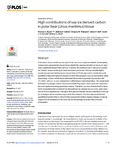High contributions of sea ice derived carbon in polar bear (Ursus maritimus) tissue.
| dc.contributor.author | Brown, Thomas | |
| dc.contributor.author | Galicia, MP | |
| dc.contributor.author | Thiemann, GW | |
| dc.contributor.author | Belt, Simon | |
| dc.contributor.author | Yurkowski, DJ | |
| dc.contributor.author | Dyck, MG | |
| dc.date.accessioned | 2018-02-07T18:08:06Z | |
| dc.date.available | 2018-02-07T18:08:06Z | |
| dc.date.issued | 2018-01-23 | |
| dc.identifier.issn | 1932-6203 | |
| dc.identifier.issn | 1932-6203 | |
| dc.identifier.other | ARTN e0191631 | |
| dc.identifier.uri | http://hdl.handle.net/10026.1/10749 | |
| dc.description.abstract |
Polar bears (Ursus maritimus) rely upon Arctic sea ice as a physical habitat. Consequently, conservation assessments of polar bears identify the ongoing reduction in sea ice to represent a significant threat to their survival. However, the additional role of sea ice as a potential, indirect, source of energy to bears has been overlooked. Here we used the highly branched isoprenoid lipid biomarker-based index (H-Print) approach in combination with quantitative fatty acid signature analysis to show that sympagic (sea ice-associated), rather than pelagic, carbon contributions dominated the marine component of polar bear diet (72-100%; 99% CI, n = 55), irrespective of differences in diet composition. The lowest mean estimates of sympagic carbon were found in Baffin Bay bears, which were also exposed to the most rapidly increasing open water season. Therefore, our data illustrate that for future Arctic ecosystems that are likely to be characterised by reduced sea ice cover, polar bears will not only be impacted by a change in their physical habitat, but also potentially in the supply of energy to the ecosystems upon which they depend. This data represents the first quantifiable baseline that is critical for the assessment of likely ongoing changes in energy supply to Arctic predators as we move into an increasingly uncertain future for polar ecosystems. | |
| dc.format.extent | e0191631-e0191631 | |
| dc.format.medium | Electronic-eCollection | |
| dc.language | en | |
| dc.language.iso | en | |
| dc.publisher | Public Library of Science (PLoS) | |
| dc.subject | Animals | |
| dc.subject | Arctic Regions | |
| dc.subject | Carbon | |
| dc.subject | Ecosystem | |
| dc.subject | Ice Cover | |
| dc.subject | Seawater | |
| dc.subject | Ursidae | |
| dc.title | High contributions of sea ice derived carbon in polar bear (Ursus maritimus) tissue. | |
| dc.type | journal-article | |
| dc.type | Journal Article | |
| dc.type | Research Support, Non-U.S. Gov't | |
| plymouth.author-url | https://www.ncbi.nlm.nih.gov/pubmed/29360849 | |
| plymouth.issue | 1 | |
| plymouth.volume | 13 | |
| plymouth.publication-status | Published online | |
| plymouth.journal | PLoS One | |
| dc.identifier.doi | 10.1371/journal.pone.0191631 | |
| plymouth.organisational-group | /Plymouth | |
| plymouth.organisational-group | /Plymouth/Faculty of Science and Engineering | |
| plymouth.organisational-group | /Plymouth/Faculty of Science and Engineering/School of Geography, Earth and Environmental Sciences | |
| plymouth.organisational-group | /Plymouth/REF 2021 Researchers by UoA | |
| plymouth.organisational-group | /Plymouth/REF 2021 Researchers by UoA/UoA07 Earth Systems and Environmental Sciences | |
| plymouth.organisational-group | /Plymouth/Research Groups | |
| plymouth.organisational-group | /Plymouth/Research Groups/Marine Institute | |
| plymouth.organisational-group | /Plymouth/Users by role | |
| plymouth.organisational-group | /Plymouth/Users by role/Academics | |
| plymouth.organisational-group | /Plymouth/Users by role/Researchers in ResearchFish submission | |
| dc.publisher.place | United States | |
| dcterms.dateAccepted | 2017-12-28 | |
| dc.identifier.eissn | 1932-6203 | |
| dc.rights.embargoperiod | Not known | |
| rioxxterms.versionofrecord | 10.1371/journal.pone.0191631 | |
| rioxxterms.licenseref.uri | http://www.rioxx.net/licenses/all-rights-reserved | |
| rioxxterms.licenseref.startdate | 2018-01-23 | |
| rioxxterms.type | Journal Article/Review |


